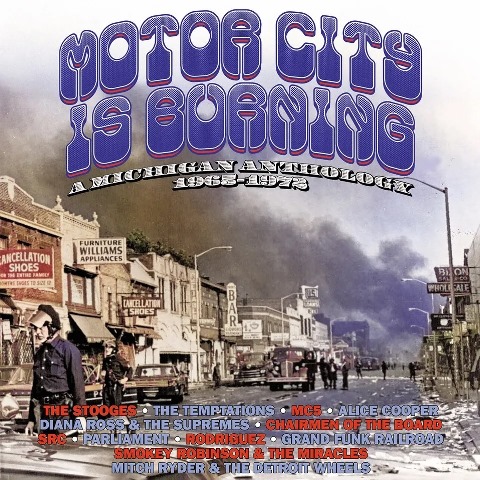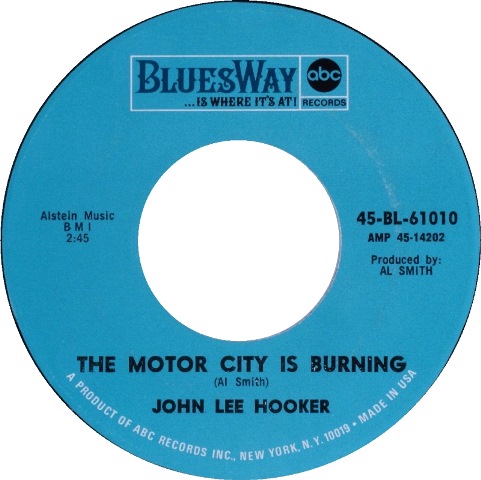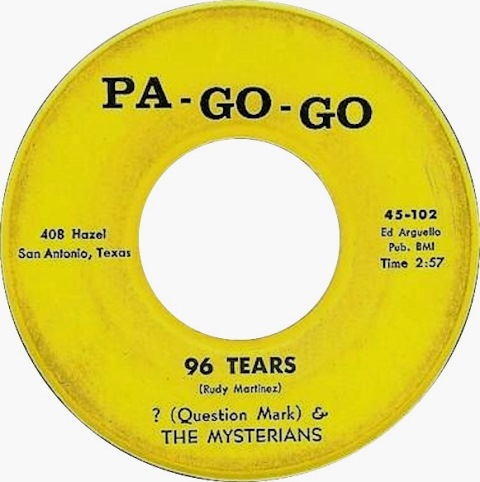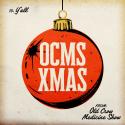In October 1967, John Lee Hooker released a single titled “The Motor City is Burning.” The song commented on the civil unrest which had taken place in his Michigan home city of Detroit that July. “Oh, the motor city's burnin',” sang Hooker. “My home town burnin' down to the ground, Worser than Vietnam, Well, it started on 12th and Clairmont, this mornin'.”
A couple of years on, Detroit’s MC5 released their version of “Motor City is Burning” (no “The”) on their debut album, the live set Kick Out The Jams. Now, the title is borrowed for the three-CD clamshell box Motor City Is Burning - A Michigan Anthology 1965-1972 which does exactly what its title says: it collects music from the state of Michigan for the specified period.
 The choice of 1965 as the jumping-off point isn’t explained in the booklet. And, in the event, there is only one track from that year: Mitch Ryder and the Detroit Wheels’ “Jenny Take a Ride!,” issued in November 1965. The way the set’s track selection is arranged is neat. Disc One collects 28 tracks from 1965 (that Mitch Ryder cut being the sole entrant from then) to 1968 and focuses on garage rock, soul-rock and the punkier end of things. Disc Two is hairier, heavier, rockier, covers 1969 to 1972 and collects Frijid Pink, Grand Funk Railroad, MC5, SRC, The Stooges and more. Disc Three is slanted towards the edgier aspects of soul and also dips into blues and jazz, with tracks from 1967 to 1972. John Lee Hooker’s “The Motor City is Burning” appears on this disc.
The choice of 1965 as the jumping-off point isn’t explained in the booklet. And, in the event, there is only one track from that year: Mitch Ryder and the Detroit Wheels’ “Jenny Take a Ride!,” issued in November 1965. The way the set’s track selection is arranged is neat. Disc One collects 28 tracks from 1965 (that Mitch Ryder cut being the sole entrant from then) to 1968 and focuses on garage rock, soul-rock and the punkier end of things. Disc Two is hairier, heavier, rockier, covers 1969 to 1972 and collects Frijid Pink, Grand Funk Railroad, MC5, SRC, The Stooges and more. Disc Three is slanted towards the edgier aspects of soul and also dips into blues and jazz, with tracks from 1967 to 1972. John Lee Hooker’s “The Motor City is Burning” appears on this disc.
The set’s opening track is ? (Question Mark) & The Mysterians’ “96 Tears.” Gratifyingly, it’s the original Pa-Go-Go label version of the song rather than the re-recording which ended up on the national US charts. Four hours on it all ends with track 67, Ruth Copeland’s freaky, by-turns Dr. John and Janis Joplin-esque 1971 version of the Stones’ “Gimme Shelter.” Some obvious choices aren’t heard. The liner notes say that Funkadelic, Ted Nugent (presumably this includes his in-absentia band The Amboy Dukes), Bob Seger and Stevie Wonder were not licensable, which is a pity. The Jagged Edge and The Up aren’t here. It would have been good if they were. On the garage/punk axis, the well is deep and any number of bands could have been included instead of those who are here. However, the presence of Detroit’s The Pleasure Seekers (who Suzi Quatro was in) and The Luv’d Ones (from Niles, Michigan) would have been nice to shift the balance away from an all-male one. Nonetheless, this is a fine overview.
 Getting to grips with when Detroit – and therefore Michigan – was looked at from a musical perspective more broad than that of being Motown’s home is an inexact science. Mitch Ryder and the Detroit Wheels chose a pointed name, and there were tons of urban and suburban garage bands. But “Detroit” as a brand took some time to bed in. In early March 1968, the Ann Arbor newspaper The Warren-Forest Sun carried an article declaring “Detroit is turning into rock city before our eyes, and we love it!” (astonishingly, this was eight years before Kiss recorded their song “Detroit Rock City”).
Getting to grips with when Detroit – and therefore Michigan – was looked at from a musical perspective more broad than that of being Motown’s home is an inexact science. Mitch Ryder and the Detroit Wheels chose a pointed name, and there were tons of urban and suburban garage bands. But “Detroit” as a brand took some time to bed in. In early March 1968, the Ann Arbor newspaper The Warren-Forest Sun carried an article declaring “Detroit is turning into rock city before our eyes, and we love it!” (astonishingly, this was eight years before Kiss recorded their song “Detroit Rock City”).
The piece went on: “All over the country groups are being ‘discovered,’ and cities like Boston are being hailed as ‘the new San Francisco,’ and San Francisco goes on as the new Liverpool, and meanwhile the scene in Detroit just gets scarier and scarier and no one seems to pay it any notice. The kids here are just beginning to find out how heavy the Detroit music scene is.” Just how heavy was underlined by noting that local band The Rationals supported The Byrds at Detroit’s Grande Ballroom and duly blew the headliners away. The Byrds were “wholly lacklustre.” The Rationals were “really smoking.”
 It continued: “[Boston cod-psych band] The Beacon Street Union came to town behind a huge promotion campaign by MGM and had to follow the MC5 on stage at the Grande. It was really sad to watch, and worse to hear. Rumor has it that the Boston band sent word back home that they didn't ever want to follow a band like that on stage for the rest of their tour – and probably, the rest of their lives.” Jimi Hendrix, it was said, didn’t stack up against local bands: “all they [the audience] got was a tired-out listless Jimi with fucked-up equipment that got there late. The Thyme and the MC5 both sparkled in pitifully short 15-minute sets.”
It continued: “[Boston cod-psych band] The Beacon Street Union came to town behind a huge promotion campaign by MGM and had to follow the MC5 on stage at the Grande. It was really sad to watch, and worse to hear. Rumor has it that the Boston band sent word back home that they didn't ever want to follow a band like that on stage for the rest of their tour – and probably, the rest of their lives.” Jimi Hendrix, it was said, didn’t stack up against local bands: “all they [the audience] got was a tired-out listless Jimi with fucked-up equipment that got there late. The Thyme and the MC5 both sparkled in pitifully short 15-minute sets.”
As the Warren-Forest Sun attested – with understandably boosterish hyperbole – there was a scene, and when the Detroit-based Creem magazine began publishing in March 1969 local music gained a flagpole on which it could further display its colours. Later, in May 1970, the also-partisan Detroit Free Press declared “There's nothing small-time about Detroit in the music business. More and more, record company executives come here first to tap talent. They know it's here. They want it. Take the Frijid Pink. Until a few months ago, they played to high schools and small clubs in Detroit. Today they are one of the groups most in demand in North America. Or the Savage Grace, who are on the brink of an international popularity equal to that of any major group. The MC5 are known everywhere. The Stooges and Catfish are headlines in New York and along the entire East Coast. And the Grand Funk Railroad – well, they're something else…the biggest rock act out of the fertile fields of Detroit.” All, except Catfish, are on Motor City Is Burning.
The biggest acknowledgement of the scene came in December 1972 with Creem editor Lester Bangs’ lengthy “Detroit's Rock Culture” article in Phonograph Record magazine. Over 5300 words, it went in to it all: the bands, the history, the context. Detroit’s music had its oracle. A cautionary one though. The article had a downbeat payoff. For Bangs, by late 1972, “the scene has declined to the point that nobody really expects much more than the absolute perfunctories anymore, and all that talk about ‘high energy’ seems to have gotten side-tracked somewhere.” Just as well then that the chronology of Motor City Is Burning - A Michigan Anthology 1965-1972 ends when it does.
- Next week: 1001 Est Crémazie – Canadian private-pressing jazz album from 1975 resurfaces
- More reissue reviews on theartsdesk
- Kieron Tyler’s website















Add comment